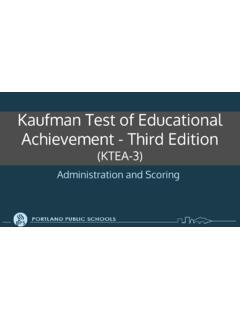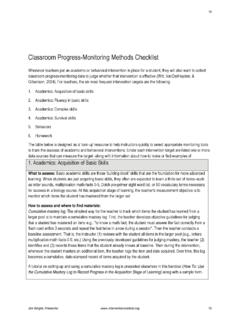Transcription of Ultimate List of IEP Accommodations, Modifications ...
1 More information at Copyright 2018 , pg. 1 Ultimate List of IEP Accommodations, Modifications & Strategies (SDIs) IEP accommodations and strategies for environment 1. a quiet area to complete the work or take a test 2. having someone read a test to them 3. "preferential seating," means sitting near the front, or away from distraction or in their area of preference (if they prefer a left or right visual field) 4. preferential seating for hearing/audio 5. preferential seating away from distractions, windows, doors, speakers 6. extra time to complete the work or reading given 7. early dismissal from class to get to locker and to next class 8. identify and limit distractions 9. opportunity for practice 10. "hot pass" or "cool off card" which is a card the student gets and they can leave class, flash the hot pass to the teacher, and go to office, guidance counselor, nurse (designated ahead of time) to cool off, if they feel a negative behavior coming on 11.
2 High contrast materials, limited visual clutter 12. adapted lunch setting to reduce sensory stressors 13. adapted recess with adult lead activities to increase peer interactions 14. recess and group activities to be designed with IEP goals in mind 15. keep days and activities structured 16. structured seating arrangements 17. small group instruction 18. access to resource room or learning support room SDIs and accommodations for transitions 1. visual cues in hallways to guide child to next classroom or cafeteria 2. personal time outs to regroup and prepare for transition 3. time warnings and increased transition time 4. advance notice of transitions 5. schedule on blackboard (or whiteboard/smartboard, I know, I'm old using the word blackboard) Tools and Equipment-SDIs and accommodations 1. visual charts 2. visual schedules 3.
3 Visual cues in locker, lunch box, on desk 4. fidget spinners/fidget toys More information at Copyright 2018 , pg. 2 5. written schedules on locker, lunch box 6. graphic organizers 7. choice cards 8. emotions cards 9. ear plugs or headphones 10. special seating-seat pads, sit-upon balls, etc. 11. adaptive equipment-pens, pencils, calculators, fidgety toys, large print books, audio, etc. 12. use of FM headsets to either have blocking out music, or FM transmission of teacher speaking, use Beatz or something else socially acceptable, blocks out outside noise 13. rewards charts 14. yoga, meditation, relaxation techniques 15. use of a scribe or oral testing to open ended or essay formats 16. provide a study guide 17. provide audio recordings 18. provide video/audio recordings 19. voice recognition software 20. extra set of text books-1 set for home, 1 for school 21.
4 Pencil grips, slant boards 22. develop a sensory diet 23. spelling dictionary, spell checker 24. provide notes, outlines or organizers with key concepts or terms highlighted 25. mnemonics 26. remind student to wear glasses/hearing aids 27. allow use of preferred writing implement Language-based SDIs and accommodations 1. minimal use of open-ended statements or questions 2. do not use sarcasm or inferences when communicating with the student 3. allow 5 or 10 seconds (whatever child needs) processing time when a request is made 4. chunk down verbal instructions 5. use only 1 question or instruction task at a time if child cannot do 2-3 parts questions 6. speak slower 7. use literal language 8. Use of first____, then_____. 9. having someone read the material to them 10. concise, direct prompts 11. clear, concise instructions that are at child's ability 12.
5 Activity based learning 13. explain metaphors and double meanings 14. limit oral questions to the number that the child can manage 15. provide direct feedback in appropriate settings More information at Copyright 2018 , pg. 3 People and Peer based accommodations and SDIs 1. special sign or signal between teacher and student to notify student of something 2. encourage but do not force eye contact; forcing eye contact may break train of thought 3. buddy system for unstructured times 4. peer to peer tutoring as appropriate 5. structured social skills groups 6. set up opportunities for child to self-advocate 7. peer modeling-appropriate play, interaction 8. role play 9. social stories 10. pair with student prior to learning a new task 11. cooperative games rather than win/lose 12. facilitated socialization at recess, lunch, breaks 13.
6 Education sessions for peers to help them understand disability 14. watch videos of social stories/interactions and ask to explain 15. role playing-both with successful and undesired outcomes (ie-troubleshooting) Sensory Accommodations and SDIs 1. give sensory breaks-have child carry down attendance sheets or just a few envelopes down to office to allow for movement 2. timed bathroom breaks (every 60, 90 120 minutes) 3. awareness of sensory issues--smells, sounds, lighting; adjust as appropriate 4. scheduled sensory breaks 5. Make sure you see the full printable list below! Behavior SDIs and Accommodations 1. frequent reinforcement for desired/positive behaviors 2. token board 3. intersperse preferred and non-preferred tasks 4. agenda check list for check-ins with preferred staff member 5. task strip with preferred activity at the end Testing and Assignments-SDIs and accommodations 1.
7 Monthly, weekly or bi-weekly phone or in person conferences with parents (progress monitoring) 2. homework assignments chunked down by teacher to define each task 3. have child write down verbal questions to aide in processing 4. breaking down tests into segments 5. pre-teaching information, then post-teaching afterwards 6. alternatives for completing assignments (typed instead of written, or verbal) More information at Copyright 2018 , pg. 4 7. provide facilitated experiences 8. frequent test breaks with opportunities to move 9. testing in a study carrel 10. testing in the morning only 11. masking test items so only single questions are visible 12. permission to hand in all assignments late, as pre-determined 13. modify assignments to only include essential content 14. intersperse easy and difficult demands on an 80/20 basis (and work to increase) 15.
8 Longer assignments broken down and scheduled out in pictures or words Miscellaneous, interventions for perceived cognitive and academic deficits 1. alarms as reminders-phone, wristwatch, etc. 2. AM/PM check in with preferred staff person 3. use of prompt hierarchy 4. incorporate child's personal interests into activities whenever possible 5. to do lists 6. journal 7. show example of completed projects 8. picture calendar or schedule 9. when appropriate and will not cause a distraction-guide student through real life situations 10. provide with calming strategies 11. test format to tap "recognition memory" such as matching or multiple choice rather than fill in blank without a word bank NVLD Suggested strategies include teaching, then re-teaching; getting the child to explain things back in his own words; and requiring the use of words different from the ones used in the initial explanation.
9 These strategies will push the child to process and hold on to the information that has been presented rather than to offer rote repetition. 1. Rehearse getting from place to place 2. Minimize transitions and give several verbal cues before transition 3. Avoid assuming the student will automatically generalize instructions or concepts 4. Verbally point out similarities, differences and connections; 5. Number and present instructions in sequence; 6. Simplify and break down abstract concepts, 7. Explain metaphors nuances and multiple meanings in reading material 8. Answer the student s questions when possible, but let them know a specific number (three vs. a few) and that you can answer three more at recess, or after school 9. Allow the child to abstain from participating in activities at signs of overload More information at Copyright 2018 , pg.
10 5 10. Thoroughly prepare the child in advance for field trips, or other changes, regardless of how minimal 11. Implement a modified schedule or creative programming 12. Never assume child understands something because he or she can parrot back what you ve just said 13. Offer added verbal explanations when the child seems lost or registers confusion 14. Phonology is intact mastery of the sound system 15. Morphology which deals with with inflectional word marking is also adequate. 16. Syntax including the formation of complete sentences and the use of various sentence types is described as age appropriate. IT APPEARS THAT LANGUAGE STRUCTURE IS NOT AN AREA OF DYSFUNCTION FOR THESE CHILDREN. NVLD-Remediation Ideas 1. Have your child use the computer at school and at home for schoolwork. 2. Help your child learn organizational and time management skills.










